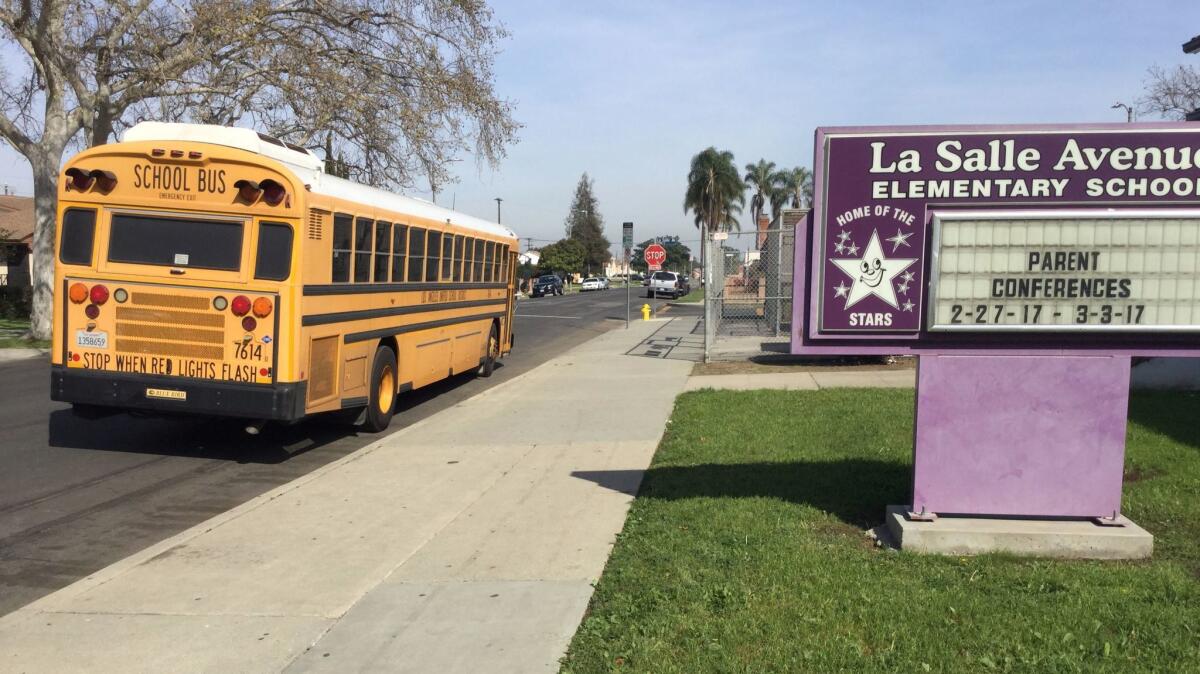Advocates say L.A. Unified shortchanges its neediest students

No one questions that students at La Salle Avenue Elementary, with their low academic achievement, could use a hand up.
But a civic coalition spearheaded by United Way of Greater Los Angeles puts the South L.A. campus at the top of schools needing more services and attention, while the L.A. Unified School District, ranks it at 293 out of 451 elementary schools.
That dichotomy is at the heart of two new reports, an ongoing lawsuit and a now yearly push to change the way the nation’s second-largest school district does business. The pressure has had some effect, but the coalition remains unsatisfied.
This particular dispute centers on one of Gov. Jerry Brown’s core reforms: providing extra money to serve students who are in the foster system, from low-income backgrounds and learning English. Because 82% of L.A. Unified students fall into at least one of these categories, the dollars add up to about $1.1 billion of the district’s $8.4 billion annual operating budget.
Critics accuse the district of using this fact essentially to spend the money anywhere, a central claim in a 2015 lawsuit. In recent times, L.A. Unified has used increased state revenues from various sources to restore or add to services to all students and to give employees a salary increase — of 10 percent — after eight years without one.
“If you have students who are generating those dollars, they should be the ones receiving services from those dollars,” said Sara Mooney, education program officer for the local United Way.
L.A. Unified Supt. Michelle King said in a statement that she values this input. The district provided no counter analysis.
At La Salle, about 93% of students are from low-income black or Latino families. More than half of the Latino children are learning English. On standardized tests, 2% of students meet or exceed state goals in English; 5% in math.
So how does the district rank La Salle 293rd? La Salle has much competition when it comes to need, but the district’s formula for discerning need also is a factor.
The district tabulates its ranking based on the percentage of low-income, English-learner and foster students — the groups the state wants it to focus on.
Critics say the assessment needs more context, including neighborhood conditions such as health outcomes and exposure to violence as well as test scores, suspension rates and dropout rates. The district also makes no special allowance for extreme poverty.
“There is a large difference between a community with a median income of approximately $35,000 (e.g., Hollywood) and a median income of approximately $25,000 (e.g., Watts), which is not fully captured by the LAUSD Need Index,” according to a new report by the Partnership for Los Angeles Schools, which manages 19 schools on behalf of L.A. Unified.
La Salle is district-run, and second-year Principal Aleta Parker-Taylor says she makes the most of the resources she has — some ongoing, some new.
She just added an assistant principal and a psychiatric social worker to strengthen mental-health support. She employs two part-time aides for safety and supervision and four teacher aides to help her 20 teachers. A library aide comes every other week and a nurse one day a week. Two carts of computers allow access for up to two classes at a time. She’s applied for a grant for a third cart.
She’d like more mental health and social support services for families, both inside and outside of school.
A key point of debate has to do with the way that the district staffs schools. L.A. Unified provides teachers based on the number of students and generally without regard to whether a teacher earns a high or low salary based on years of experience or additional training. So two schools could have the same number of students and teachers but vastly different staffing costs.
The class size at La Salle mirrors most district campuses: about 24 to 1 in early grades; 31 to 1 for grades 4 and 5.
More experienced (and expensive) teachers tend to migrate away from the most difficult schools, so the district frequently spends more on teachers at the “better” schools.
If the district committed to spend more at needier schools, it might get higher-paid, more experienced teachers or more teachers, said UC Berkeley education professor Bruce Fuller, who with colleague Joonho Lee prepared a report released Monday for the coalition.
Such an approach, however, would upend district practices and come up against unionized instructors, who have won the right to apply to work at schools of their choice.
“There is this good news thread” at the high school level, Fuller said, where the district is spending more dollars as the state intended, largely through adding non-teaching staff such as counselors. “The district did exercise its discretion to try to lift kids in these high-needs high schools.”
More to Read
Sign up for Essential California
The most important California stories and recommendations in your inbox every morning.
You may occasionally receive promotional content from the Los Angeles Times.











